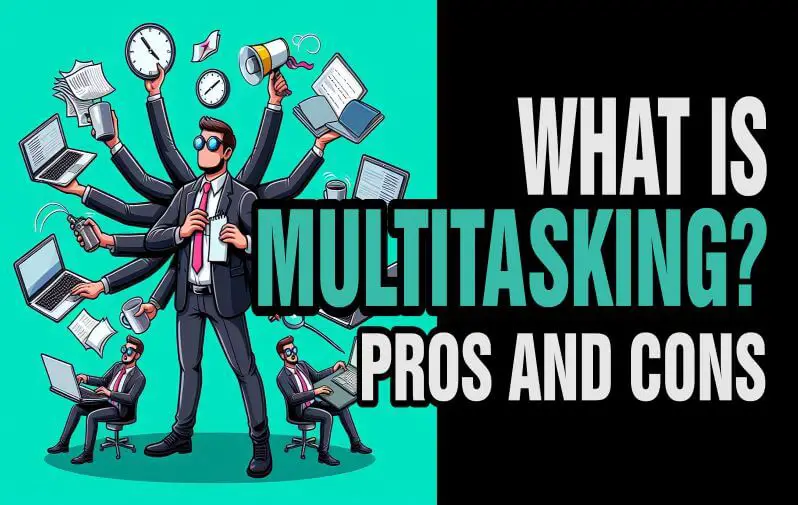Last updated on July 14th, 2024 at 04:38 pm
What is multitasking? Explore the concept of multitasking or juggling multiple tasks at a time and its impact on productivity and mental well-being.
Multitaskers have always been regarded as smart people as they can complete multiple tasks at the same time. But trouble brewing!
The ability to handle multiple tasks simultaneously is a skill highly valued in today’s fast-paced world.
While it may seem like a productivity booster, its effects on efficiency and mental well-being are a subject of debate.
Understanding the pros and cons of handling multiple tasks at a time is crucial for individuals striving to optimize their performance.
This article will reach deep into what task-juggling is, and the potential benefits and drawbacks, shedding light on whether it is truly advantageous or detrimental to your overall effectiveness.
Related: 10 Task Juggling Skills You Should Master
Table of Contents
- What is Multitasking?
- Is Multitasking a Myth or is Multitasking Possible
- The Impact of Multitasking on Job Performance
- Are Women Better at Multitasking?
- Pros and Cons of Multitasking
- Examples of Multitasking
- Types of Multitasking
- Multitasking and Technology
- Multitasking in Different Scenarios
- Finding Balance and Strategies for Improving Handling Multiple Tasks at a Time
- How to Stop Multitasking
- Why is Multitasking Dangerous to Memorization?
- Multitasking Test
- Frequently Asked Questions
- Final Thoughts
What is Multitasking?
Multitasking Definition
Handling multiple tasks at a time is the ability to perform multiple tasks at the same time or to switch rapidly between two or more tasks.
It has become a defining feature of our modern society, where people are constantly attempting to balance work, personal life, and technology.
Handling multiple tasks at a time is often seen as a desirable skill to have, particularly in the workplace, where the ability to juggle, multiple tasks may lead to increased productivity and efficiency.
Organizations may demand that employees juggle multiple tasks simultaneously, or individuals may feel pressure to check their phones or engage in other distractions constantly.
As technology continues to evolve and the pace of life continues to accelerate, the practice of juggling tasks will likely continue to be a defining feature of modern society.
Related: Your Brain Depreciates with Multitasking
Is Multitasking a Myth or is Multitasking Possible

There is an ongoing debate among experts about the concept of simultaneous tasking.
Some argue that humans are not capable of true juggling, as our brains can only actively focus on one task at a time.
They argue that what we perceive as multiple-tasking is rapidly switching your attention between different activities.
Others, however, believe that humans can multitask to some extent, particularly when the tasks involve different areas of the brain.
Research suggests that attempting to multitask can lead to reduced productivity and increased errors due to divided attention.
When you switch between tasks, your brain needs time to refocus, which can result in inefficiency.
Therefore, while it may seem like we can do multiple things simultaneously, it is likely that the brain is simply alternating attention between tasks, making juggling tasks more of a myth than a reality.
Related: Helping Teenagers in Balancing Multitasking
The Impact of Multitasking on Job Performance
Of course, handling multiple tasks at a time has an impact on job performance either positively or negatively.
Let’s take a closer look at this:
Time Management Challenges and Potential Burnout
Handling multiple tasks at a time can lead to time management challenges, as individuals may struggle to allocate sufficient attention to each task.
This can result in increased stress and potential burnout, particularly if employees consistently feel overwhelmed by the volume of tasks they are expected to manage.
Decreased Creativity and Innovation
Dividing attention across multiple tasks can hinder deep focus and creative thinking.
Employees may find it challenging to generate innovative ideas or problem-solve effectively when their attention is divided among various responsibilities.
Increased Stress and Decreased Job Satisfaction
Juggling can contribute to heightened stress levels, as you may feel pressure to constantly switch between tasks and meet competing deadlines.
This can lead to decreased job satisfaction and overall well-being.
Lowers the Intelligence Quotient (IQ)
Another research approached the subject from another angle of lowering the human IQ apart from slowing you down.
A University of London study discovered that participants who multitasked at a cognitive task had a decline in IQ score that resembled what was expected when marijuana is consumed or the effect experienced when stayed awake at night.
It stressed that task-juggling dropped men’s IQ to that of an 8-year-old child. It could be observed that handling multiple tasks in a gathering makes a person absent-minded to a task while appearing confused at another and this indicates low social awareness, an emotional smartness (EQ) component that is necessary for success wherever.
Also Read: Understanding Intellectual Curiosity
Are Women Better at Multitasking?
A study published in BMC Psychology conducted by UK psychologists found that men were slower and less organized than women when switching between tasks quickly.
Both sexes struggled with balancing priorities, but men faced more challenges overall.
Dr. Gijsbert Stoet of the University of Glasgow suggested that if men are indeed slower at handling multiple tasks at once, it could impact workplace expectations.
The issue of juggling tasks has become increasingly important in the workplace, but interruptions can significantly affect productivity.
Previous research has produced varied results on gender and handling multiple tasks at once, with some studies showing women outperforming men and others suggesting men may excel in certain juggling task scenarios.
In the study, both men and women slowed down and made more errors as the switching between tasks accelerated, but men exhibited a 77% longer response time compared to women’s 69%.
See more reports on this by BBC.
Pros and Cons of Multitasking
Pros of Handling Multiple Tasks at Once
Though juggling tasks is believed to be detrimental to the brain, here are the advantages of combining tasks:
Increased Productivity: It allows people to accomplish more tasks in a shorter amount of time. By working on several tasks simultaneously, individuals can complete more work than they would have been able to by focusing on one task at a time.
Better Time Management: Requires individuals to prioritize tasks and manage their time effectively. This skill is valuable in both personal and professional settings.
Improved Cognitive Skills: It can help improve cognitive skills, such as attention, memory, and executive function. Several studies have shown that individuals who regularly multitask have better mental agility and can quickly shift their attention between tasks.
Flexibility: Juggling tasks requires individuals to be flexible and adaptable in their approach to completing tasks. This skill can be beneficial in the workplace, where unforeseen challenges and changes often arise.
Increased Efficiency: When you multitask, you can work more efficiently by completing small tasks during downtime or breaks between more significant projects. This can help prevent wasted time and increase overall productivity.
Cons of Handling Multiple Tasks at a Time
Here are the disadvantages of juggling tasks:
Decreased Productivity: Studies have shown that attempting to juggle multiple tasks can decrease overall productivity, as the brain becomes overwhelmed and unable to focus effectively on any one thing.
Reduced Creativity: Juggling tasks can reduce the ability to think creatively and develop new ideas, as the brain is constantly switching and unable to fully engage with any one task.
Increased Stress Levels: Trying to do too many things at once can lead to increased stress levels, as the brain is working overtime to process all the information and demands being thrown its way.
Impaired Decision-making: When handling multiple tasks, it can be difficult to make informed decisions, as the brain is pulled in multiple directions and may not be able to give each decision the necessary attention.
Reduced Work Quality: Attempting to multitask can lead to errors and oversights, resulting in lower-quality work and potentially costly mistakes.
Examples of Multitasking

Here are a few examples:
Working While Attending a Conference Call: During a remote conference call, a person can engage in juggling tasks by simultaneously listening to the discussion, taking notes, responding to emails, or completing other work-related activities.
Cooking While Watching TV: While cooking a meal, a person can multitask by watching a TV show or movie in the background. They can follow the recipe instructions and keep an eye on the food while enjoying their favorite program.
Texting While Walking: Many individuals multitask by texting or talking on the phone while walking. This allows them to communicate with others while still being able to move from one location to another.
Exercising While Listening to an Audiobook: People often multitask during their workout routines by listening to audiobooks or podcasts. This allows them to engage in physical activity while simultaneously gaining knowledge or entertainment through the audio content.
Studying With Background Music: Students often multitask by playing soft background music while studying. This may help create a conducive environment for learning by providing a soothing backdrop, without significantly distracting them from their studying.
Chatting with Friends while Doing Household Chores: While performing mundane household tasks such as cleaning, laundry, or cooking, individuals may multitask by chatting with friends or family members through phone calls, video calls, or text messages.
Types of Multitasking
Task juggling can be broadly categorized into two main types: simultaneous multitasking and task-switching multitasking.
Let’s take a look:
1. Simultaneous Multitasking
Simultaneous task juggling refers to performing multiple tasks at the same time.
This type of task juggling involves dividing attention between multiple activities simultaneously.
Examples include:
Physical Multitasking: Physical task juggling involves the simultaneous performance of multiple physical tasks. For instance, carrying groceries while talking on the phone.
Cognitive Multitasking: Cognitive task juggling involves performing multiple mental tasks simultaneously. It might include studying while listening to music or watching TV.
Parallel Multitasking: Parallel task-juggling refers to running multiple processes concurrently on a computer. For example, using multiple software applications simultaneously or downloading files while browsing the internet.
2. Task-Switching Multitasking
Task-switching involves switching between multiple tasks or activities rapidly.
Instead of performing tasks simultaneously, this type focuses on switching attention between different tasks sequentially.
Examples include:
Context-switching: This occurs when you switch attention between various projects or tasks throughout the day. For instance, transitioning from responding to emails to attending meetings to working on a specific project.
Interruption-driven Multitasking: This type of handling multiple tasks at a time occurs when you are forced to switch tasks due to external interruptions. For example, answering phone calls, responding to instant messages, or attending to unexpected requests.
Priority-based Multitasking: Priority-based task juggling has to do with assigning different levels of importance to tasks and then switching attention according to their priorities. It requires frequent reassessment of task importance and reorganizing one’s focus based on the changing requirements.
Multitasking and Technology

Technology plays a big part in influencing how you multitask. Let’s take a closer look at the following factors:
Technology provides various tools, devices, and platforms that enable you to handle multiple tasks simultaneously.
For example, smartphones, tablets, and laptops allow you to access various applications, complete different assignments, and communicate with others all at once.
This has led to an increase in the expectation and ability to multitask in both personal and professional settings.
The Influence of Social Media and Smartphones
Social media platforms and smartphones have had a profound influence on task-juggling behaviours.
These technologies have made it easier for individuals to engage in multiple activities simultaneously, such as checking emails, texting, browsing the internet, and using social media while listening to music or watching videos.
It has become common for people to switch between different applications or tasks rapidly, often driven by notifications and constant connection to social networks.
How Technology Affects Multitasking Abilities
While technology has made handling multiple tasks at a time more accessible, it has also been found to negatively impact your task-juggling abilities.
Studies have shown that frequent multitaskers, influenced by technology, may experience reduced attention span, decreased cognitive performance, and difficulties in maintaining focus on a single task.
The constant switching between tasks can lead to a decrease in productivity and quality of work, as attention is divided across multiple activities.
Potential Addictive Nature of Handling Multiple Tasks at a Time
Task juggling, facilitated by technology, can become addictive due to the constant stimulation and reward systems associated with completing tasks or receiving notifications.
The instant gratification provided by checking social media updates or receiving messages can lead to a compulsive need to continuously engage in multiple activities simultaneously.
This addictive nature can result in a decrease in well-being, increased stress levels, and hindered personal relationships as you struggle to break away from the task-juggling habit.
Multitasking in Different Scenarios
Multitasking at Work
In a work environment, juggling tasks refers to the ability to handle multiple tasks simultaneously or switch between tasks efficiently.
For example, a project manager may simultaneously communicate with team members, review reports, attend meetings, and respond to emails.
Handling multiple tasks in this scenario can help increase productivity, save time, and ensure smooth workflow.
However, it is important to effectively prioritize tasks and manage time to avoid overload or compromising the quality of work.
Multitasking in Education
Handling multiple tasks in education involves performing multiple educational activities at the same time.
Students often multitask by studying while listening to lectures or taking notes.
It can also involve working on assignments while conducting research or participating in group discussions.
Task juggling in education can be beneficial in terms of time management and consolidating knowledge from different sources.
However, excessive juggling may lead to decreased concentration, reduced learning retention, or hinder deep thinking and critical analysis.
Multitasking and Daily Life Activities
Handling multiple tasks in daily life activities is the ability to juggle multiple tasks or responsibilities outside of work or education.
Examples include cooking while doing household chores, listening to a podcast or audiobook while exercising or commuting, or checking emails and messages while having meals.
Task juggling in daily life activities can help you efficiently use your time and accomplish multiple tasks simultaneously.
However, it is important to strike a balance and avoid becoming overwhelmed or compromising the quality of activities.
Multitasking and Personal Relationships
Juggling in personal relationships involves dividing attention between spending time with loved ones and engaging in other activities.
For instance, simultaneous tasking might involve watching a movie or TV show while having a conversation with a partner, or browsing social media on a phone while spending time with family.
While handling many tasks at the same time can help manage personal obligations and entertainment, it may negatively impact the quality of interactions and communication in relationships.
Being fully present and giving undivided attention to loved ones is important for building and maintaining healthy relationships.
Finding Balance and Strategies for Improving Handling Multiple Tasks at a Time
Finding a balance with attending to multiple tasks at a time involves several key elements as you are going to see below:
1. Recognizing when Task Juggling is Beneficial and when it is not
Firstly, it is important to recognize when juggling tasks is beneficial and when it is not.
Certain tasks lend themselves well to juggling, such as listening to a podcast while doing household chores or checking emails during a less intense work task.
However, some tasks require undivided attention, such as studying for an exam or having an important conversation with someone.
Recognizing the difference between these situations helps in prioritizing tasks and deciding when it is appropriate to multitask.
2. Identifying Personal Multitasking Tendencies
Another aspect is identifying personal juggling tendencies. Some individuals may naturally excel at handling several tasks at once and find it easy to switch between these tasks, while others may struggle with it and experience decreased productivity.
Understanding your capabilities and limitations when it comes to juggling tasks can help in determining when it is feasible and when it is better to focus on one task at a time.
3. Mindfulness Techniques for Better Focus and Concentration
Additionally, incorporating mindfulness techniques can improve focus and concentration while handling multiple tasks.
Mindfulness involves being fully present and aware of the current moment, which can reduce distractions and enhance productivity.
Techniques such as deep breathing exercises, meditation, or setting intentions can help maintain concentration while engaging in multiple tasks.
4. Establishing Healthy Boundaries with Technology
Lastly, establishing healthy boundaries with technology is crucial for finding a balance with multitasking.
With the prevalence of smartphones, social media, and notifications, it can be easy to become constantly distracted and overwhelmed.
Setting specific times for checking messages or browsing social media, turning off unnecessary notifications, or implementing technology-free periods can create healthier boundaries and minimize distractions, allowing for more effective task juggling.
How to Stop Multitasking
To stop multitasking, follow these steps:
Recognize the Negative Effects: Understand and acknowledge the negative impacts of juggling tasks on productivity and quality of work. It often leads to decreased focus, increased errors, and reduced efficiency.
Prioritize Tasks: Begin by identifying and listing down the tasks you need to complete. Take note of any deadlines or time-sensitive projects. Assess each task’s importance and urgency to determine which tasks require your immediate attention.
Focus on One Task at a Time: Select the most important and urgent task from your list and dedicate your full attention to it. Avoid distractions like email notifications, social media, or phone calls during this time. Close unnecessary tabs on your computer and put your phone on silent mode or in another room.
Time Blocking: Allocate specific time blocks for different tasks throughout your day. For instance, set aside a specific hour or two to reply to emails, hold meetings, or complete specific projects. Create a schedule that allows you to concentrate on one task without interruptions.
Use Task Management Techniques: Explore various techniques like the Pomodoro Technique, which involves working for 25-30 minutes without interruptions, followed by a short break. Repeat this cycle a few times and then take a more extended break. Such techniques can boost your focus and productivity.
Delegate and Outsource: If you have too much on your plate, consider delegating or outsourcing tasks that don’t require your direct involvement. This allows you to focus on your most critical responsibilities and reduce the need for juggling tasks.
Set Realistic Expectations: Understand that you are not superhuman and can’t do everything at once. Be realistic about what you can accomplish within a given timeframe and communicate those limitations to others.
Take Breaks: It may sound counterintuitive, but allowing yourself regular breaks helps maintain focus and productivity. During these breaks, avoid checking work-related emails or engaging in other tasks. Instead, take a short walk, practice deep breathing, or engage in a mindful activity to recharge your mind.
Why is Multitasking Dangerous to Memorization?
Working on multiple tasks at once is dangerous to memorization because it splits your attention and impairs your ability to focus on a single task.
When you engage in multiple activities simultaneously, your brain is constantly switching between tasks, leading to reduced concentration and attention span.
This hampers the encoding of information into your memory systems, making it difficult to retain and recall information later.
The brain requires uninterrupted processing and concentration to form strong neural connections for effective memorization.
Handling multiple tasks at a time diverts cognitive resources and disrupts the consolidation of memories, resulting in poor retention and recall.
Additionally, it often leads to increased stress levels, which further impairs memory function.
Thus, to improve memorization, minimizing distractions and prioritizing focused attention on a single task at a time is crucial.
Multitasking Test
A multitasking test is designed to measure your ability to perform multiple tasks simultaneously or switch between different tasks efficiently.
It evaluates cognitive skills such as attention, memory, and problem-solving while managing various activities concurrently.
Participants are often presented with a variety of activities or stimuli, such as responding to emails, solving puzzles, or listening to instructions, and their performance is assessed based on accuracy, speed, and task-switching abilities.
This type of assessment is frequently used in job selection processes, where the ability to multitask is crucial, such as in administrative or managerial roles.
Frequently Asked Questions
What do you mean by multitasking?
It refers to the ability to perform multiple tasks or activities simultaneously or in rapid succession.
What is the meaning of multitasker?
A multitasker is a person who can efficiently handle and switch between multiple tasks or activities without losing productivity or quality.
What is the definition of multitasking in the workplace?
In the workplace, it involves managing and executing multiple tasks or projects simultaneously, often requiring quick transitions between different responsibilities.
Final Thoughts
Multitasking is a complex skill that offers both advantages and disadvantages.
While it can increase productivity in certain situations, it may also lead to decreased efficiency and heightened stress.
Understanding when to multitask and when to focus on single tasks is crucial.
By recognizing the potential trade-offs and learning to prioritize effectively, you can harness the benefits of juggling tasks while mitigating their drawbacks, ultimately optimizing your overall performance and well-being.
References:
- Understanding task juggling
- Meaning of task juggling
- Everything to know about handling multiple tasks at a time
Pyo Merez (PsyD) is a distinguished adolescent and adult psychologist at the forefront of mental health advocacy.
With expertise in cognitive and developmental psychology, focusing on social relationships, cultural contexts, and individual differences, Pyo has dedicated his career to empowering adolescents and adults.
As a sought-after speaker and panelist, Pyo shares invaluable insights on issues affecting young people, contributing to a deeper understanding of mental health and well-being in today's society.


